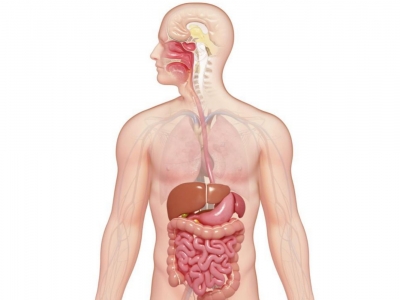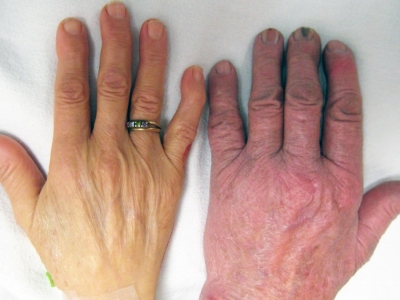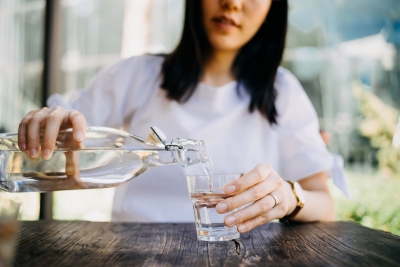
Ever wondered what happens to the food you eat once you swallow? The digestive system will be busy at work on your dinner for the next few hours - or sometimes days - depending upon what you've eaten. This process, called digestion, allows your body to get the nutrients and energy it needs from the food you eat. So let's find out what's happened to that mouthful you just ate.
Esophagus
The esophagus is kind of like a pipe that's about 25 cm long. It moves food from the back of your throat to your stomach. But also at the back of your throat is your windpipe, which allows air to come in and out of your body. When you swallow a small ball of chewed-up food or liquids, a special flap called the epiglottis flops down over the opening of your windpipe to make sure the food enters the esophagus and not the windpipe. Once food has entered the esophagus, the muscle walls move in a wavy motion to slowly squeeze the food down through the esophagus. This takes about two or three seconds.
Liver
The nutrient-rich blood comes directly to the liver for processing. The liver filters out harmful substances or wastes, turning some of the waste into more bile. The liver even helps figure out how many nutrients will go to the rest of the body, and how many will stay behind in storage.
Small intestine
At over six metres long the small intestine isn't small at all. The small intestine is a long tube that's about 3.5 to 5 cm round, and it's packed inside beneath your stomach. The small intestine breaks down the food mixture even more, so your body can absorb all the vitamins, minerals, proteins, carbohydrates, and fats with a little help from three other organs: the pancreas, liver, and gallbladder.
Those organs send different juices to the first part of the small intestine. These juices help to digest food and allow the body to absorb nutrients. The pancreas makes Juices that help the body digest fats and protein. A juice from the liver called bile helps to absorb fats into the bloodstream. And the gallbladder serves as a warehouse for bile, storing it until the body needs it.
Your food may spend as long as four hours in the small intestine and will reduce to a very thin watery mixture. At the end of the journey, the nutrients from your dinner can pass from the intestine into the blood. Once in the blood, your body is closer to benefiting from the complex carbohydrates and vitamins.
Mouth
Even before you eat, when you smell a tasty food, see it, or think about it, digestion begins. Saliva begins to form in your mouth. When you do eat, the saliva breaks down the chemicals in the food, which helps make the food mushy and easy to swallow. Your tongue helps out, pushing the food around while you chew with your teeth. When you're ready to swallow, the tongue pushes a tiny bit of mushed-up food called a bolus toward the back of your throat and into the opening of your esophagus, the second part of the digestive tract.
Stomach
Your stomach is attached to the end of the esophagus. It's a sack that has three important jobs:
- To store the food you've eaten.
- To break down the food into a liquid mixture.
- To slowly empty that liquid mixture into the small intestine. The stomach is like a mixer, churning together all the small balls of food that came down the esophagus into smaller and smaller pieces. It does this with help from the strong muscles in the walls of the stomach and gastric juices that also come from the stomachs' walls. Gastrio juices also help kill bacteria that might be in the eaten food.
Large intestine
At around 7 to 10 am, the large intestine is fatter than the small intestine and it's almost the last stop on the digestive tract. Like the small intestine, it is packed into the body, and would measure about 1.5 metres long if you spread it out. After most of the nutrients are removed from the food mixture, there is waste left over - stuff your body can't use. This stuff needs to be passed out of the body.
Colon
Before the waste goes, it passes through the part of the large intestine called the colon which is where the body gets its last chance to absorb the water and some minerals into the blood. As the water leaves the waste product, what's left gets harder and harder nu it keep moving along, until it becomes a sold. Yep, it’s a poo, (also called stool or a bowel movement).
The large intestine pushes the solid waste into the rectum, the very last stop on the digestive tract. The solid waste stays here until you are ready to go to the toilet.
Looking after your digestive system
You can help your digestive system by drinking water and eating a healthy diet that Includes foods rich in fibre. High-fibre foods, like fruits, vegetables, and whole grains, make it easier for waste to pass through your system. The digestive system is a pretty important part of your body. Without it, you couldn't get the nutrients you need to grow properly and stay healthy. And next time you sit down to lunch, you know where your food goes - from start to finish!
Picture Credit : Google








